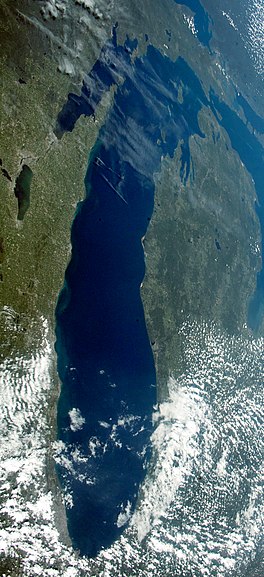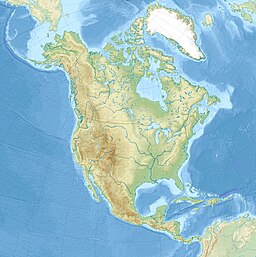
Back Michiganmeer Afrikaans بحيرة ميشيغين Arabic ܝܡܬܐ ܕܡܝܫܝܓܢ ARC ميشيجان (بحيره) ARZ Llagu Michigan AST Miçiqan gölü Azerbaijani Мичиган (күл) Bashkir Danu Michigan BAN Мічыган (возера) Byelorussian Мичиган (езеро) Bulgarian
| Lake Michigan | |
|---|---|
 Lake Michigan viewed from the International Space Station (August 19, 2019). Chicago sits at the extreme S.W. of the lake. | |
 | |
| Location | United States |
| Group | Great Lakes |
| Coordinates | 44°N 87°W / 44°N 87°W |
| Lake type | Glacial |
| Primary inflows | Straits of Mackinac, Fox River, Grand River, Menominee River, Milwaukee River, Muskegon River, Kalamazoo River, St. Joseph River |
| Primary outflows | Straits of Mackinac; also, controlled discharge through locks on the Chicago River (and its North Shore Channel), and Calumet River |
| Basin countries | United States |
| Max. length | 307 mi (494 km) |
| Max. width | 118 mi (190 km) |
| Min. width | 91 mi (146 km) |
| Surface area | 22,404 sq mi (58,030 km2)[5] |
| Average depth | 279 ft (85 m) |
| Max. depth | 923 ft (281 m)[6] |
| Water volume | 1,183 cu mi (4,930 km3) |
| Residence time | 99 years |
| Shore length1 | 1,400 mi (2,300 km) plus 238 mi (383 km) for islands[7] |
| Surface elevation | 577 ft (176 m)[6] |
| Islands | see list |
| Settlements | see list |
| References | [6] |
| 1 Shore length is not a well-defined measure. | |
Lake Michigan (/ˈmɪʃɪɡən/ ⓘ MISH-ig-ən) is one of the five Great Lakes of North America. It is the second-largest of the Great Lakes by volume[5] (1,180 cu mi; 4,900 km3) and depth (923 ft; 281 m) after Lake Superior and the third-largest by surface area (22,405 sq mi; 58,030 km2), after Lake Superior and Lake Huron. To the east, its basin is conjoined with that of Lake Huron through the wide and deep Straits of Mackinac, giving it the same surface elevation as its easterly counterpart; hydrologically, the two bodies are a single lake that is, by area, the largest freshwater lake in the world.[8]
Lake Michigan is the only Great Lake located fully in the United States; the other four are shared between the U.S. and Canada. It is the world's largest lake, by area, located fully in one country,[9] and is shared, from west to east, by the U.S. states of Wisconsin, Illinois, Indiana, and Michigan. Ports along its shores include Chicago, Illinois, Gary, Indiana, Milwaukee and Green Bay, Wisconsin, and Muskegon, Michigan. To the north, the lake is flanked by long bays, including Green Bay in the northwest, and Grand Traverse and Little Traverse bays in the northeast. The word michigan is believed to come from the Ojibwe ᒥᓯᑲᒥ[10] (michi-gami or mishigami), meaning "great water".[11]
- ^ National Geophysical Data Center Archived April 3, 2015, at the Wayback Machine, 1996. Bathymetry of Lake Michigan. National Geophysical Data Center, NOAA. doi:10.7289/V5B85627 [access date: March 23, 2015].
- ^ National Geophysical Data Center Archived April 3, 2015, at the Wayback Machine, 1999. Bathymetry of Lake Huron. National Geophysical Data Center, NOAA. doi:10.7289/V5G15XS5 [access date: March 23, 2015]. (only small portion of this map)
- ^ National Geophysical Data Center, 1999. Global Land One-kilometer Base Elevation (GLOBE) v.1. Archived February 10, 2011, at the Wayback Machine Hastings, D. and P.K. Dunbar. National Geophysical Data Center, NOAA. doi:10.7289/V52R3PMS [access date: March 16, 2015].
- ^ "About Our Great Lakes: Tour". National Oceanic and Atmospheric Administration (NOAA), Great Lakes Environmental Research Laboratory (GLERL). Archived from the original on May 7, 2017. Retrieved December 15, 2017.
- ^ a b "Lake Michigan". Great-lakes.net. June 18, 2009. Archived from the original on January 1, 2010. Retrieved January 14, 2010.
- ^ a b c Wright 2006, p. 64
- ^ Shorelines of the Great Lakes Archived April 5, 2015, at the Wayback Machine
- ^ "Great Lakes Map". Michigan Department of Environmental Quality. 2013. Archived from the original on November 26, 2011. Retrieved August 26, 2013.
- ^ Routley, Nick (February 23, 2019). "The World's 25 Largest Lakes, Side by Side". Visual Capitalist. Archived from the original on June 21, 2021. Retrieved December 19, 2020.
- ^ first form is as spelled in Ojibwe native syllabics
- ^ "Superior Watershed Partnership Projects". Archived from the original on September 28, 2007.
